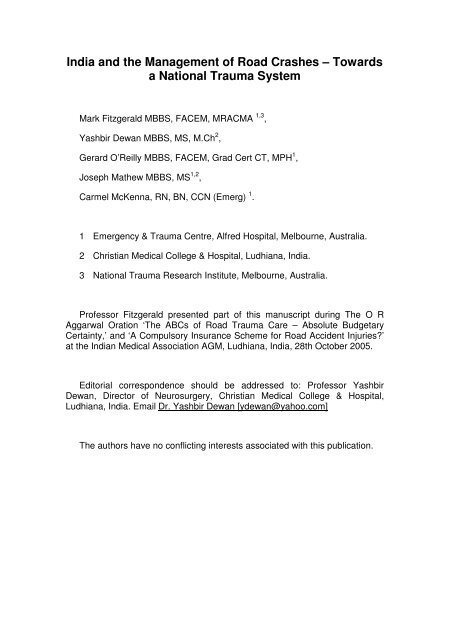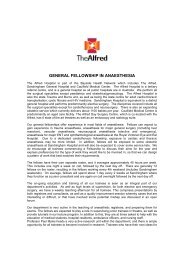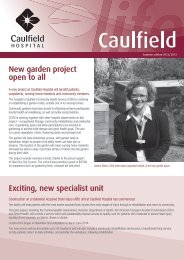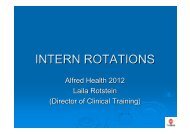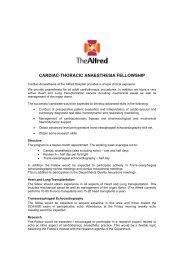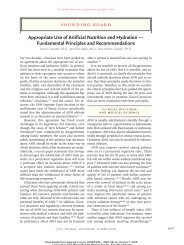India and the Management of Road Crashes ... - Alfred Hospital
India and the Management of Road Crashes ... - Alfred Hospital
India and the Management of Road Crashes ... - Alfred Hospital
- No tags were found...
Create successful ePaper yourself
Turn your PDF publications into a flip-book with our unique Google optimized e-Paper software.
<strong>India</strong> <strong>and</strong> <strong>the</strong> <strong>Management</strong> <strong>of</strong> <strong>Road</strong> <strong>Crashes</strong> – Towardsa National Trauma SystemMark Fitzgerald MBBS, FACEM, MRACMA 1,3 ,Yashbir Dewan MBBS, MS, M.Ch 2 ,Gerard O’Reilly MBBS, FACEM, Grad Cert CT, MPH 1 ,Joseph Ma<strong>the</strong>w MBBS, MS 1,2 ,Carmel McKenna, RN, BN, CCN (Emerg) 1 .1 Emergency & Trauma Centre, <strong>Alfred</strong> <strong>Hospital</strong>, Melbourne, Australia.2 Christian Medical College & <strong>Hospital</strong>, Ludhiana, <strong>India</strong>.3 National Trauma Research Institute, Melbourne, Australia.Pr<strong>of</strong>essor Fitzgerald presented part <strong>of</strong> this manuscript during The O RAggarwal Oration ‘The ABCs <strong>of</strong> <strong>Road</strong> Trauma Care – Absolute BudgetaryCertainty,’ <strong>and</strong> ‘A Compulsory Insurance Scheme for <strong>Road</strong> Accident Injuries?’at <strong>the</strong> <strong>India</strong>n Medical Association AGM, Ludhiana, <strong>India</strong>, 28th October 2005.Editorial correspondence should be addressed to: Pr<strong>of</strong>essor YashbirDewan, Director <strong>of</strong> Neurosurgery, Christian Medical College & <strong>Hospital</strong>,Ludhiana, <strong>India</strong>. Email Dr. Yashbir Dewan [ydewan@yahoo.com]The authors have no conflicting interests associated with this publication.
Abstract<strong>Road</strong> trauma in <strong>India</strong> is a significant health <strong>and</strong> socio-economic burdenwhich requires urgent attention. When compared to countries with establishedTrauma Systems, those injured in <strong>India</strong> have up to a six-fold higher mortalityrate. The death rate would be reduced with better organised systems <strong>of</strong>trauma care. This is dependent on State authorities introducing systems thatfund accident prevention along with <strong>the</strong> organised care <strong>of</strong> <strong>the</strong> injured.The goal <strong>of</strong> an effective Trauma System should be to provide universalemergency care with equity <strong>of</strong> access. The belief that trauma care cannot becost effective in low-income settings needs to be refuted. Better planning willresult in cost-effective improvements in patient outcomes. However, withoutprotected <strong>and</strong> guaranteed funding schemes, <strong>the</strong> development <strong>of</strong> TraumaSystems in <strong>India</strong> will fail.Key WordsTrauma Systems, funding, preventable death2
IntroductionAccidental injury is one <strong>of</strong> <strong>the</strong> leading causes <strong>of</strong> mortality <strong>and</strong> morbidity in<strong>India</strong>. <strong>India</strong> has one per cent <strong>of</strong> total vehicles in <strong>the</strong> world but accounts for 6per cent <strong>of</strong> total road accidents. There are approximately 400,000 roadcrashes causing injury in <strong>India</strong> each year, resulting in 85,000 deaths <strong>and</strong> 1.2million seriously injured. The World Health Organization (WHO) has projectedthat by 2020 road accidents will be a major killer in <strong>India</strong> accounting for546,000 deaths <strong>and</strong> 15,314,000 disability adjusted life years lost [1,2] .WHO figures for 2000 indicate that <strong>India</strong> has a disproportionately highdeath rate due to road traffic injuries - 29 per 100,000 people - more than twice<strong>the</strong> rate <strong>of</strong> developed nations. Underpinning this mortality rate is <strong>India</strong>’s highrate <strong>of</strong> road crashes. The accident rate <strong>of</strong> 35 per thous<strong>and</strong> vehicles in <strong>India</strong> isone <strong>of</strong> <strong>the</strong> highest in <strong>the</strong> world. There is an associated annual fatality rate <strong>of</strong>25.3 per 10,000 motor vehicles. This translates to a serious <strong>India</strong>n road crashevery few minutes. Many accidents are not reported. Deaths from all types <strong>of</strong>injuries are projected to increase 1.47 fold from 1990 to 2020 - with road trafficinjuries <strong>the</strong> major cause for this increase [1,2] .Compounding <strong>the</strong> high crash incidence is <strong>the</strong> lack <strong>of</strong> organised care for <strong>the</strong>injured. Evidence indicates that people with life-threatening, but potentiallytreatable injuries are up to six times more likely to die in a country with noorganised trauma system than in one with an organised, resourced traumasystem [3] .The State <strong>of</strong> Kerala, for example, leads <strong>the</strong> country in certain social <strong>and</strong>health indicators such as literacy <strong>and</strong> health equity, yet has one <strong>of</strong> <strong>the</strong> highestmotor vehicle crash rates in <strong>the</strong> country, with <strong>the</strong> third-highest absolutenumber <strong>of</strong> road accidents. There are approximately 2,500,000 registeredvehicles in Kerala, with 39,500 crashes <strong>and</strong> 2,700 road accident deathsreported in 2003. This equates to an associated annual fatality rate <strong>of</strong> 12 per10,000 motor vehicles. This compares with a comparative rate in Australia <strong>of</strong>1.8 per 10,000 motor vehicles – a six-fold difference. Not surprisingly, roadcrashes are <strong>the</strong> commonest cause <strong>of</strong> death for people under <strong>the</strong> age <strong>of</strong> 35.Apart from <strong>the</strong> human cost, <strong>the</strong> financial cost resulting from road crashinjuries is significant. Death <strong>and</strong> disability following road crashes causesignificant costs through years <strong>of</strong> productive life lost <strong>and</strong> <strong>the</strong> ongoing costs <strong>of</strong>care. The estimated cost <strong>of</strong> road crashes in <strong>India</strong> is 2% <strong>of</strong> <strong>the</strong> Gross DomesticProduct [4] . For example, <strong>the</strong> direct cost per annum <strong>of</strong> road crashes in Keralais estimated to be Rs 300 crore per annum (US$ 75,000,000 per annum) [5] .These costs will continue to rise if <strong>the</strong> road toll continues to increase.Injury PatternsPublished road crash data from Delhi indicates that 41% <strong>of</strong> injured arepedestrians, 27% motorcyclists <strong>and</strong> 14% pedal cyclists [6] . Data from Kerala3
indicates that 56% <strong>of</strong> road crashes involve riders <strong>of</strong> 2-wheeled vehicles. Themajority <strong>of</strong> road crash patients do not require extrication.A Mumbai study published in 2004 prospectively studied 1074 severelyinjured patients. Head trauma was present in <strong>the</strong> majority (76%) <strong>of</strong> <strong>the</strong>patients in this study <strong>and</strong> severe head injuries accounted for 47% <strong>of</strong> allpatients with head injury. Severe thoracic <strong>and</strong> abdominal injuries were 0.6 <strong>and</strong>8.2% <strong>of</strong> all <strong>the</strong> thoracic <strong>and</strong> abdominal injuries, respectively [7] .For most <strong>of</strong> <strong>India</strong>, <strong>the</strong> wearing <strong>of</strong> helmets for motorcyclists is not m<strong>and</strong>atory<strong>and</strong>/or not enforced. Brain injury following motorcycle crashes is common.Traumatic brain injuries are a leading cause <strong>of</strong> morbidity, mortality, disability<strong>and</strong> socioeconomic losses in <strong>India</strong>. <strong>Road</strong> traffic injuries are <strong>the</strong> leading cause(60%) <strong>of</strong> brain injury, followed by falls (20%-25%) <strong>and</strong> violence (10%). Alcoholinvolvement is known to be present among 15%-20% at <strong>the</strong> time <strong>of</strong> injury. Therehabilitation needs <strong>of</strong> brain injured persons are significantly high <strong>and</strong>increasing from year to year [8] .PreventionAs previously described, prevention schemes – such as <strong>the</strong> wearing <strong>of</strong>helmets for motorcyclists – have had variable support <strong>and</strong> enforcement in<strong>India</strong>. Prevention strategies can contribute up to a two-thirds reduction in roadtrauma mortality.The State <strong>of</strong> Victoria in Australia has a successful history in reduction <strong>of</strong>deaths <strong>and</strong> disability from trauma over <strong>the</strong> past 35 years. Primary preventionincluding world-first m<strong>and</strong>atory seat-belt legislation in 1970, compulsorybicycle helmets, r<strong>and</strong>om alcohol breath testing, speed cameras <strong>and</strong> m<strong>and</strong>atoryblood tests for hospitalised trauma patients substantially reduced <strong>the</strong> <strong>Road</strong>Toll. Between 1970 <strong>and</strong> 1994 <strong>the</strong> fatality rate decreased from 8.1 to 1.4 per10,000 registered vehicles <strong>and</strong> from 30.8 to 8.4 per 100,000 population [9] .Prevention strategies coincided with <strong>the</strong> development <strong>of</strong> a State administered,no-fault, compulsory, transport insurance scheme. It was in <strong>the</strong> insurer’sinterest to reduce pay-outs by supporting legislative change <strong>and</strong> policeenforcement. This economic driver was a key feature underpinning <strong>the</strong> morestringent compliance with <strong>and</strong> enforcement <strong>of</strong> road laws.Trauma <strong>Management</strong>Evidence from developed countries indicates that properly coordinatedearly rescue <strong>and</strong> retrieval systems toge<strong>the</strong>r with appropriate early, in-hospitaltrauma management will prevent 15 - 30% <strong>of</strong> road crash deaths [10] .The first hour after a crash is crucial to a person’s survival <strong>and</strong> in limiting<strong>the</strong> extent <strong>of</strong> injury. Evidence from <strong>the</strong> United States, Europe <strong>and</strong> Australasiaindicates that <strong>the</strong>re are three major contributors to death following road4
trauma. The two key physical causes are airway obstruction <strong>and</strong> blood loss.These two factors can not only quickly lead to death, but can also makeresuscitation more difficult <strong>and</strong> lead to longer term complications if allowed topersist. The third major threat is delay to surgical treatment. This includes <strong>the</strong>provision <strong>of</strong> timely, adequate <strong>and</strong> appropriate emergency care at <strong>the</strong> accidentsite, expeditious delivery to hospital <strong>and</strong> appropriate treatment on arrival <strong>and</strong>during subsequent hospitalisation. All stages <strong>of</strong> care provided requireintegration.Prehospital CareIn most countries <strong>the</strong> majority <strong>of</strong> trauma deaths occur outside <strong>of</strong> hospital.Following initial care at <strong>the</strong> crash scene, transport to hospital becomes acritical factor in trauma management. At least one third <strong>of</strong> potentiallypreventable deaths occur prior to arrival at hospital, <strong>and</strong> over half occur during<strong>the</strong> hospital reception <strong>and</strong> resuscitation phase <strong>of</strong> care [10] .Prehospital emergency care in <strong>India</strong> is only beginning to develop. Thirtyper cent <strong>of</strong> emergency patients in <strong>India</strong> die before <strong>the</strong>y reach a hospital. It isknown that <strong>the</strong> first hour after injury is critical to both <strong>the</strong> survival <strong>of</strong> <strong>the</strong> injured<strong>and</strong> <strong>the</strong>ir injury outcome. Over 80 per cent <strong>of</strong> accident victims do not getaccess to medical care within one hour <strong>of</strong> <strong>the</strong> incident [11] . Long delays occurgetting <strong>the</strong> injured to hospital. A recently published study from Mumbai notedthat for severely injured patients, <strong>the</strong> time between <strong>the</strong> injury <strong>and</strong> hospitaladmission averaged 6 hours [7] .Prehospital care at road crash sites in <strong>India</strong> is inconsistent <strong>and</strong> unreliable -with minimal, if any, medical intervention <strong>and</strong> long delays to hospital. There isa lack <strong>of</strong> State organised emergency ambulance services. Police numbers aresignposted along state highways, but ambulance numbers are not. The vastmajority <strong>of</strong> ambulances are used for inter-hospital transfer – not for primaryresponse. Finding a suitable vehicle at <strong>the</strong> accident site is not easy. Personswho shift <strong>the</strong> victims are usually untrained members <strong>of</strong> <strong>the</strong> public. There is nolinkage with hospital trauma services [12] . Crash victims are <strong>of</strong>ten taken to <strong>the</strong>nearest hospital, regardless <strong>of</strong> <strong>the</strong> hospital’s capabilities for dealing withtrauma.Within <strong>the</strong> large population centres in <strong>India</strong>, locally managed attempts toimprove prehospital care have begun. However, <strong>the</strong> st<strong>and</strong>ard <strong>of</strong> medical care– specifically airway management, haemorrhage control <strong>and</strong> splinting – isprovided at no more than a basic first aid level. Whilst used to transport <strong>the</strong>injured, <strong>the</strong> auto-rickshaw is an inappropriate transport platform for seriouslyinjured patients <strong>and</strong> <strong>the</strong> driver is unable to provide care whilst driving. Manypatients are transported to hospital in <strong>the</strong> rear seats <strong>of</strong> taxis, reliant on friendsproviding care en route to hospital.Rapid access to crash sites using strategically located emergencyambulance vehicles is achievable on national <strong>and</strong> state highways in <strong>India</strong>. Forexample, a recent Government <strong>of</strong> Kerala proposal for Trauma Care <strong>and</strong>5
Accident <strong>Management</strong> Units noted that if major emergency facilities werelocated at 80-100 km. intervals along major roads, 95-98% <strong>of</strong> <strong>the</strong> populationwould have access to emergency care within one hour [13] .In <strong>the</strong> cities <strong>and</strong> villages where <strong>the</strong>re are narrow <strong>and</strong> congested roadsmotorcycle paramedics could provide a rapid response to crash scenes ifrequired. Motorcycle paramedics based in built up areas already exist in parts<strong>of</strong> <strong>India</strong> (e.g. Ludhiana, Punjab), Western Europe <strong>and</strong> Australasia.The group <strong>of</strong> people most likely to be first at <strong>the</strong> scene <strong>of</strong> an accidentshould be targeted for a public awareness campaign. In most instances,motorists (or o<strong>the</strong>r passers by) will be <strong>the</strong> first on <strong>the</strong> accident scene. Thepublic should be informed <strong>of</strong> <strong>the</strong>ir responsibilities <strong>and</strong> how to render a basiclevel <strong>of</strong> first aid without fear <strong>of</strong> being held liable. Public first aid posters shouldbe displayed prominently on buses, along with public prevention campaignposters targeting, for example, helmet wearing <strong>and</strong> safer driving.Commercial vehicles <strong>and</strong> bus operators should be encouraged to carry acomprehensive first-aid kit in order to provide immediate response to injuries,pending pr<strong>of</strong>essional assistance. A goal should be that a current first-aidcertificate is a requirement for licensing.Appropriately equipped (with staff trained for effective trauma response)ambulance services should continue to be developed. Ideal staffing for eachambulance is a driver <strong>and</strong> 1 or 2 attendants, with <strong>the</strong> attendants undergoing acertified life support program to a Basic Emergency Medical Technicianst<strong>and</strong>ard (airway management, suction, oxygen administration, splinting,wound compression <strong>and</strong> haemorrhage control).<strong>Hospital</strong> Reception <strong>and</strong> ResuscitationThe published literature related to trauma resuscitation in <strong>India</strong> is scant.Although well established in North America, <strong>the</strong> United Kingdom <strong>and</strong>Australasia, <strong>the</strong> development <strong>of</strong> Emergency Medicine as a recognisedspecialty has not yet occurred in <strong>India</strong>.Organised trauma reception <strong>and</strong> resuscitation is difficult at many hospitalsin <strong>India</strong>. There is <strong>of</strong>ten no warning <strong>of</strong> <strong>the</strong> pending arrival <strong>of</strong> major traumapatients, <strong>and</strong> <strong>the</strong>refore no preparation. Attendance to a trauma patient is <strong>of</strong>tendelayed. Triage at hospital can be ineffectual or performed by non-clinicalstaff. In most <strong>India</strong>n hospitals <strong>the</strong>re is no trauma team or callout, <strong>and</strong> nointerdisciplinary approach to trauma reception. There is a single systemapproach to care, which is problematic when dealing with severely injured roadcrash patients who have multi-system injuries.Few hospitals have dedicated, equipped space for major traumaassessment <strong>and</strong> resuscitation. Senior surgical, emergency or anaes<strong>the</strong>ticpresence in <strong>the</strong> setting <strong>of</strong> <strong>the</strong> initial trauma management is uncommon.6
As previously mentioned, <strong>the</strong> lack <strong>of</strong> an effective trauma triage systemdelays <strong>the</strong> care <strong>of</strong> trauma patients. Triage guidelines need to be implementedto improve <strong>the</strong> trauma resuscitation process. A designated, trained triagenurse can categorize patients according to <strong>the</strong>ir level <strong>of</strong> injury, transfer traumapatients to an appropriate area <strong>and</strong> notify medical staff.It is difficult to quantify how much <strong>the</strong> lack <strong>of</strong> organised <strong>and</strong> consistenthospital reception <strong>and</strong> resuscitation contributes adversely to patient outcome.However, a sentinel study based on autopsy data <strong>of</strong> road traffic fatalities inSouth Delhi in 1989 demonstrated that 64% <strong>of</strong> deaths were preventable orpotentially preventable. The majority <strong>of</strong> preventable deaths resulted from afailure to diagnose or treat a life-threatening injury following arrival at hospital.Adherence to established principles in <strong>the</strong> hospital management <strong>of</strong>haemorrhage could have saved 70% <strong>of</strong> preventable deaths [14] .<strong>Hospital</strong> In-patient CareThe post resuscitation care received in hospital is usually coordinated byanaes<strong>the</strong>tists <strong>and</strong> surgical staff. Organised State Trauma Registries or datacollection systems do not exist, making objective assessment difficult.Representative studies reviewing injury outcomes have been published in<strong>the</strong> <strong>India</strong>n medical literature. A study from a major hospital in Lucknowpublished in 2004 [15] used TRISS analysis [16,17,18] to review trauma mortality.The authors compared patients'outcome to an international norm <strong>and</strong> <strong>the</strong>ncomparing predicted survival to actual survival. The details <strong>of</strong> <strong>the</strong> patientswere recorded <strong>and</strong> <strong>the</strong> patients were followed until discharge or death during a6-week period. The mortality rate was 31.4%. TRISS methodology was appliedto 88.6% <strong>of</strong> patients. All survivors were identified by TRISS methodology aslikely to survive. 76% <strong>of</strong> trauma deaths during <strong>the</strong> study period wereconsidered unexpected deaths by <strong>the</strong> TRISS methodology. The reasons for<strong>the</strong> unexpected deaths were septicaemia, mannitol nephrotoxicity, aspiration<strong>and</strong> a direct result <strong>of</strong> <strong>the</strong> injury - especially in patients with burns. The authorsconcluded that although <strong>the</strong>ir hospital was <strong>the</strong> major trauma referral centre in<strong>the</strong> region, <strong>the</strong>re was a high rate <strong>of</strong> unexpected deaths <strong>and</strong> <strong>the</strong> care providedto trauma patients needed to be improved.A prospective study from a major trauma hospital in Mumbai published in2004 analysed <strong>the</strong> care <strong>and</strong> outcome <strong>of</strong> 1074 severely injured patients [7] . Thevast majority (82%) <strong>of</strong> all <strong>the</strong> cases in this study had no pre-hospital care.There is no formal Emergency Medical System in Mumbai, much like <strong>the</strong> rest<strong>of</strong> <strong>India</strong>. The police, fire brigade, individual initiatives, private ambulances <strong>and</strong>non-government organisations provided some pre-hospital care to <strong>the</strong> injured.There was no central co-ordination for trauma patients. The average age <strong>of</strong><strong>the</strong> patients was 31 years <strong>and</strong> <strong>the</strong> commonest cause <strong>of</strong> injury was road trafficcrashes. Using TRISS analysis <strong>the</strong> authors noted an observed mortality <strong>of</strong>21.26% compared to a predicted mortality <strong>of</strong> 10.89%. The authors concludedthat <strong>the</strong> injured in <strong>India</strong> were found to be older, <strong>the</strong> injuries more severe <strong>and</strong><strong>the</strong> patient outcomes poorer with significantly more deaths than predicted.7
To address <strong>the</strong> prehospital phase <strong>of</strong> care, activities to reduce accidents<strong>and</strong> <strong>the</strong> development <strong>of</strong> patient transport <strong>and</strong> ambulance services for traumaare a high priority.For <strong>the</strong> hospital phase <strong>of</strong> care, <strong>the</strong> establishment <strong>of</strong> Tertiary TraumaCentres; increasing staff numbers <strong>and</strong> experience at Trauma Centres; trainingstaff in trauma reception <strong>and</strong> resuscitation; supplying adequate equipment <strong>and</strong>an adequate supply <strong>of</strong> drugs to Trauma Centres <strong>and</strong> developing computeriseddata collection <strong>and</strong> record keeping are required. These major teachinghospitals need to be developed to form <strong>the</strong> hub <strong>of</strong> an integrated traumasystem - providing 24-hour trauma reception teams, on-site neurosurgery,cardiothoracic surgery, intensive care <strong>and</strong> o<strong>the</strong>r specialist resources to deliverdefinitive care to <strong>the</strong> majority <strong>of</strong> <strong>the</strong> <strong>India</strong>’s major trauma caseload throughprimary triage from <strong>the</strong> accident scene or following secondary, inter-hospitaltransfer. Caseload concentration facilitates <strong>the</strong> development <strong>of</strong> a core group<strong>of</strong> surgeons, anaes<strong>the</strong>tists <strong>and</strong> nurses who consistently manage large traumavolumes. Level 1 Centres are required to develop <strong>the</strong> resources <strong>and</strong> expertiseto deliver leadership <strong>and</strong> support to <strong>the</strong> trauma system as a whole.Trauma System DevelopmentThe evolving burden <strong>of</strong> injury has prompted <strong>the</strong> call for <strong>the</strong> development <strong>of</strong>organised Trauma Systems in <strong>India</strong> [19,20] . A ‘Trauma System’ comprises anintegrated, protocol driven system <strong>of</strong> care which monitors <strong>and</strong> addressesPrevention, Notification, Prehospital care, <strong>Hospital</strong> reception <strong>and</strong> resuscitation,Surgical care, In-hospital care <strong>and</strong> Rehabilitation.Optimal care <strong>of</strong> trauma patients requires an organised approach thatrecognises <strong>the</strong> complexity <strong>and</strong> time-critical nature <strong>of</strong> major injuries. Theconcept <strong>of</strong> modern trauma systems originated from experiences with <strong>the</strong>management <strong>of</strong> soldiers injured in <strong>the</strong> Korean <strong>and</strong> Vietnam Wars - whenevacuation by helicopter <strong>and</strong> refined prehospital care enabled rapid transport<strong>of</strong> patients to definitive surgical care centres <strong>and</strong> greatly reduced militarycasualty deaths [21,22] . This encouraged <strong>the</strong> development <strong>of</strong> a l<strong>and</strong>mark statewidesystem for treatment <strong>of</strong> civilian motor vehicle crash victims in Illinois in<strong>the</strong> early 1970’s [23,24] .There is substantial evidence to support <strong>the</strong> concept that <strong>the</strong> timely delivery<strong>of</strong> seriously injured patients to centres experienced in <strong>the</strong> management <strong>of</strong>major trauma optimises outcome. Implementation <strong>of</strong> a trauma system inOrange County, California improved <strong>the</strong> quality <strong>of</strong> trauma care delivered <strong>and</strong><strong>the</strong> proportion <strong>of</strong> deaths judged to be potentially preventable decreased [25] . InOregon, trauma system development led to an increased proportion <strong>of</strong> traumapatients treated at Level I trauma centres <strong>and</strong> substantially improved <strong>the</strong>survival rate [26] . In San Diego a preventable death rate <strong>of</strong> 22% in 1984 fell to2% after trauma system implementation [27] <strong>and</strong> studies from New York Statedemonstrated a significant decrease in region-wide trauma mortality aftersystem development [28] . By March 2003, 35 U.S states had implemented atrauma system.8
Although in <strong>India</strong> <strong>the</strong>re is no national lead agency to co-ordinate variouscomponents <strong>of</strong> a trauma system [29] , individual States have <strong>the</strong> opportunity tocorrect <strong>the</strong> almost complete lack <strong>of</strong> organised trauma care - <strong>and</strong> to address <strong>the</strong>lack <strong>of</strong> appropriate health infrastructure - through <strong>the</strong> formulation <strong>and</strong> adoption<strong>of</strong> State Trauma Systems.As previously indicated, evidence indicates that people with life-threatening- but potentially treatable - injuries are up to six times more likely to die in acountry with no organized trauma system than in one with an organized,resourced trauma system.<strong>Road</strong> crashes are a significant risk to <strong>the</strong> lives <strong>of</strong> all road users.Trauma does not discriminate. Effective trauma care dem<strong>and</strong>s immediateresponses from trained emergency nursing, medical <strong>and</strong> technical staff.Trauma Systems have been developed to improve outcomes. However, <strong>the</strong>development <strong>of</strong> a comprehensive trauma care system is expensive. Aconstant concern is ‘…how can you indiscriminately treat first <strong>and</strong> recoup costslater..?’A comprehensive review <strong>of</strong> <strong>the</strong> requirements <strong>and</strong> establishment <strong>of</strong> a StateTrauma System can be found in a recently published article in Injury [30] . Thestrategic principle <strong>of</strong> “<strong>the</strong> right patient to <strong>the</strong> right hospital in <strong>the</strong> shortest time”provided <strong>the</strong> basis for <strong>the</strong> plan. The article reviews <strong>the</strong> designation <strong>of</strong> specifichospitals <strong>of</strong> various levels to care for trauma patients; <strong>the</strong> concentration <strong>of</strong>trauma expertise at <strong>the</strong>se centres; integration <strong>and</strong> coordination between <strong>the</strong>service providers; development <strong>of</strong> agreed triage <strong>and</strong> transfer protocols <strong>and</strong>improved education, training <strong>and</strong> research programs. A state-wide majortrauma database was established to enable system monitoring <strong>and</strong> facilitatefur<strong>the</strong>r enhancements. This experience with <strong>the</strong> development <strong>of</strong> an integratedtrauma system should aid in <strong>the</strong> development <strong>of</strong> <strong>India</strong>n State TraumaSystems.There are two key requirements for <strong>the</strong> establishment <strong>of</strong> State ‘TraumaSystems’.The first requirement is policy development which recognises <strong>the</strong> socioeconomicburden <strong>of</strong> injury <strong>and</strong> commits governing institutions to reformpresent, inadequate systems <strong>of</strong> care. The requirement for policy developmenthas already been stressed by <strong>the</strong> World Health Organisation [1,2] <strong>and</strong> needs tobe continually stressed by interested parties - including surgical <strong>and</strong>associated medical groups who shoulder <strong>the</strong> burden <strong>of</strong> care.The second key requirement is funding. An ongoing, guaranteed fundingstream is crucial to Trauma System development.Funding for Trauma SystemsTrauma care is expensive. It has been shown that trauma mortality isinversely proportional to a country’s per capita gross national product [3,31] .9
However, successful Trauma Systems rely on equity <strong>of</strong> access, with patientstriaged on <strong>the</strong> basis <strong>of</strong> injury ra<strong>the</strong>r than <strong>the</strong>ir capacity to pay.The lack <strong>of</strong> guaranteed, recurrent funding is <strong>the</strong> major threat to a StateTrauma System establishing - <strong>and</strong> <strong>the</strong>n continuing. By <strong>the</strong> mid 1990s 100trauma centers had closed in <strong>the</strong> United States <strong>of</strong> America. The primaryreason was financial loss from treating uninsured patients [32] .The authors recommend <strong>the</strong> establishment <strong>of</strong> no fault, compulsory, thirdparty insurance schemes linked to vehicle registration or alternatively as part<strong>of</strong> an annual ‘road tax'. The scheme would cover <strong>the</strong> pre-hospital <strong>and</strong> initialhospital <strong>and</strong> medical costs <strong>of</strong> all persons injured by a registered vehicle in atransport accident on a no fault basis (drivers, passengers <strong>and</strong> pedestrians). Itwould not remove <strong>the</strong> common law rights for pecuniary loss <strong>and</strong> pain <strong>and</strong>suffering for <strong>the</strong> seriously injured. There would be oversight <strong>of</strong> medical excess<strong>and</strong> m<strong>and</strong>atory police reporting to reduce “frivolous” claims. Property damagecar insurance would still be provided by private insurance companies.The scheme is based on <strong>the</strong> Transport Accident Commission (TAC) whichoperates in Victoria, Australia. However, this latter scheme also provides longterm care for clients with major injuries <strong>and</strong> Common law liability for clientswho have a serious injury. These are <strong>the</strong> most significant areas <strong>of</strong> liabilitycovered by <strong>the</strong> latter scheme but are not recommended initially.Under <strong>the</strong> Victorian Scheme US$70,000,000 per annum covers roadrescue, ambulance, acute hospital <strong>and</strong> medical costs <strong>of</strong> those persons injuredby registered vehicles on <strong>the</strong> roads. This equates to US $22 per annum perregistered vehicle. The premium is collected automatically as part <strong>of</strong> anannual, vehicle registration process. This guarantees <strong>the</strong> premium is collected<strong>and</strong> eliminates <strong>the</strong> need to “market” insurance. The TAC’s premium is basedon 23 vehicle classes (passenger, goods, motorcycles, o<strong>the</strong>r) with smallervehicles paying cheaper premiums. Geographic risk zones (Melbourne,surrounding areas, rural) are also loaded into <strong>the</strong> premium. Similar systemsoperate in o<strong>the</strong>r Australian states <strong>and</strong> jurisdictions.A pre-paid scheme guarantees prompt payment <strong>of</strong> hospital <strong>and</strong> medicalcosts, funding <strong>of</strong> infrastructure that can <strong>the</strong>n be used for all trauma/emergencycases, <strong>the</strong> development <strong>of</strong> trauma registries for data collection, improvedstaffing <strong>and</strong> careers in trauma care – <strong>and</strong> improved patient outcomes.Guaranteed prompt payment <strong>of</strong> medical <strong>and</strong> hospital costs encouragesclinicians who wish to devote <strong>the</strong>ir careers to trauma care <strong>and</strong> provides <strong>the</strong>mwith <strong>the</strong> infrastructure required.Linked to this would be <strong>the</strong> development <strong>of</strong> appropriate training <strong>and</strong> <strong>India</strong>specificeducation schemes, such as <strong>the</strong> Primary Trauma Care (PTC) courseconducted by <strong>the</strong> World Federation <strong>of</strong> Societies <strong>of</strong> Anes<strong>the</strong>tists or <strong>the</strong> NationalTrauma <strong>Management</strong> Course (NTMC) run by <strong>the</strong> Academy <strong>of</strong> Traumatology(<strong>India</strong>) in association with <strong>the</strong> International Association for Surgery <strong>of</strong> Trauma<strong>and</strong> Surgical Intensive Care.10
A statutory authority, or equivalent, would administer <strong>the</strong> scheme whichwould fund <strong>the</strong> costs <strong>of</strong> initial medical care on a no-fault principle. A no-faultscheme guarantees payment for care from <strong>the</strong> statutory authority irrespective<strong>of</strong> who is at fault <strong>and</strong> encourages immediate hospital care <strong>and</strong> surgicalintervention for those who require it. For example, in Kerala <strong>the</strong>re are anestimated 50,000 injured in accidents each year, at a health care cost <strong>of</strong> Rs80,00,00,000 or US$ 20,000,000 per annum [5] . In 2003 <strong>the</strong>re were 2,500,000registered vehicles in Kerala, implying an average Rs 450 per annum pervehicle surcharge (US $10) which would <strong>the</strong>n be pooled to cover <strong>the</strong> scheme.Administrative costs need to be determined <strong>and</strong> a formal scoping study wouldneed to be undertaken to accurately determine <strong>the</strong> costs associated withcollection, infrastructure funding <strong>and</strong> medical <strong>and</strong> hospital care.Therefore <strong>the</strong> development <strong>of</strong> State-based, no fault insurance schemeslinked to current State health, police <strong>and</strong> road tax collection systems thatcurrently exist in <strong>India</strong> is recommended. These will have <strong>the</strong> capacity toreduce mortality rates <strong>and</strong> improve outcomes - <strong>and</strong> will be propelled by astrong economic incentive to reduce <strong>the</strong> Insurers’ outgoing expenses byreducing <strong>the</strong> incidence <strong>of</strong> road trauma. The additional income <strong>the</strong>n receivedwill be appropriately spent on developing <strong>the</strong> medical <strong>and</strong> policinginfrastructure required.ResearchThere has been significant research in trauma over <strong>the</strong> last 20 years.Although many issues are universal, some findings are more relevant to <strong>the</strong>demography from which <strong>the</strong>y are derived. This is demonstrated, for example,by <strong>the</strong> differences in <strong>the</strong> delivery <strong>of</strong> rural trauma care to <strong>the</strong> care delivered indensely populated urban environments - or <strong>the</strong> differences in systems dealingwith largely penetrating trauma compared to those systems that deal withpredominantly blunt trauma. Each <strong>India</strong>n State will need to mould <strong>the</strong>previously described generic principles to <strong>the</strong>ir own demographic.Clinical research is commonly produced by practitioners in <strong>the</strong> particularfield. Funding which fosters career development in <strong>the</strong> care <strong>of</strong> <strong>the</strong> injured willhave a lasting benefit by generating systems improvement through research.Conclusion<strong>Road</strong> trauma in <strong>India</strong> is a significant societal burden which requires urgentattention. The death rate would be reduced with better organised systems <strong>of</strong>trauma care. A reduction <strong>of</strong> <strong>the</strong> road toll is dependent on State authoritiesintroducing systems that fund accident prevention <strong>and</strong> <strong>the</strong> organised care <strong>of</strong><strong>the</strong> injured.Emergency <strong>and</strong> trauma care should not be considered a luxury for richcountries or rich individuals in poor countries [33] . The goal <strong>of</strong> an effective11
Trauma System should be to provide universal emergency care with equity <strong>of</strong>access. The belief that trauma care cannot be cost effective in low-incomesettings needs to be refuted. Accidents occur everywhere, <strong>and</strong> each dayconsume resources regardless <strong>of</strong> whe<strong>the</strong>r <strong>the</strong>re are systems capable <strong>of</strong>achieving good outcomes. Better planning will result in cost-effectiveimprovements in patient outcomes. However, without <strong>the</strong> development <strong>of</strong>protected <strong>and</strong> guaranteed funding schemes Trauma System development in<strong>India</strong> will fail.12
References1 World Report on <strong>Road</strong> Traffic Injury Prevention, WHO/World Bank,2004.2 World Health Organization. The world health report 2003: shaping <strong>the</strong>future. Geneva: WHO 2003; 95-100.3 Mock CN, Adzotor KE, Conklin E, Denno DM, Jurkovich GJ. Traumaoutcomes in <strong>the</strong> rural developing world: comparison with an urban level 1trauma center. J Trauma 1993;35:518-23.4 WHO South East Asia Regional Office, SCN Department, New Delhi -Disability, Violence - Injury, Prevention <strong>and</strong> Rehabilitation. Newsletter 2001Vol. 2 No.1.5 Government <strong>of</strong> Kerala, Department <strong>of</strong> Health <strong>and</strong> Family Welfare,Trauma Care <strong>and</strong> Accident <strong>Management</strong> Units in Kerala – DetailedImplementation Plan. Government <strong>of</strong> Kerala 2004;5-6.6 World Report on <strong>Road</strong> Traffic Injury <strong>and</strong> Prevention – Main Messages<strong>and</strong> Recommendations. World Health Organisation/World Bank 2004;5.7 Murlidhar V, Roy N. Measuring trauma outcomes in <strong>India</strong>: an analysisbased on TRISS methodology in a Mumbai university hospital. Injury. 2004Apr;35(4):386-90.8 Gururaj G. Epidemiology <strong>of</strong> traumatic brain injuries: <strong>India</strong>n scenario.Neurol Res. 2002 Jan;24(1):24-8.9 McDermott FT, Cordner SM, Tremayne AB. Evaluation <strong>of</strong> <strong>the</strong> medicalmanagement <strong>and</strong> preventability <strong>of</strong> death in 137 road traffic fatalities inVictoria, Australia: an overview. Consultative Committee on <strong>Road</strong> TrafficFatalities in Victoria. J Trauma. Apr; 40(4):520-33.10 McDermott FT, Cordner SM, Tremayne AB. Reproducibility <strong>of</strong>preventable death judgments <strong>and</strong> problem identification in 60 consecutiveroad trauma fatalities in Victoria, Australia. Consultative Committee on<strong>Road</strong> Traffic Fatalities in Victoria. J Trauma. 1997 Nov; 43(5): 831-9.11 ‘In an Emergency…’. The Hindu. June 13 2002;http://www.hindu.com/<strong>the</strong>hindu/mp/2002/06/13/stories/2002061300180300.htm. accessed 7 Jan 2006.12 Government <strong>of</strong> Kerala. Kerala Accident <strong>and</strong> Trauma Care Service(KATCAS), Who <strong>India</strong> Country Office in consultation with <strong>the</strong> Department <strong>of</strong>PWD. Feb 2005.13
13 Government <strong>of</strong> Kerala, Department <strong>of</strong> Health <strong>and</strong> Family Welfare,Trauma Care <strong>and</strong> Accident <strong>Management</strong> Units in Kerala – DetailedImplementation Plan. Government <strong>of</strong> Kerala 2004;6.14 Sahdev P, Lacqua MJ, Singh B, Dogra TD. <strong>Road</strong> traffic fatalities inDelhi: causes, injury patterns <strong>and</strong> incidence <strong>of</strong> preventable deaths. AccidAnal Prev. 1994 Jun;26(3):377-84.15 Goel A, Kumar S, Bagga MK. Epidemiological <strong>and</strong> Trauma Injury <strong>and</strong>Severity Score (TRISS) analysis <strong>of</strong> trauma patients at a tertiary care centrein <strong>India</strong>. Natl Med J <strong>India</strong>. 2004 Jul-Aug;17(4):186-9.16 Boyd CR, Tolson MA, Scopes SC. Evaluating trauma care: <strong>the</strong> TRISSmethod. J Trauma 1987;27:370-378.17 Champion HR, Copes WS, Sacco WJ, Lawnick MM, Keast SL, Bain LWJr, Flanagan ME, Frey CF. The Major Trauma Outcome Study: establishingnational norms for trauma care. J Trauma. 1990 Nov;30(11):1356-65.18 McLellan BA. Trauma severity scoring: <strong>the</strong> language <strong>of</strong> trauma. In:McMurty RY, McLellan BA, editors. <strong>Management</strong> <strong>of</strong> Blunt Trauma.Baltimore: Williams & Wilkins;1990:11-19.19 Banerjee KK, Agarwal BB, Kohli A, Aggarwal NK. Study <strong>of</strong> head injuryvictims in fatal road traffic accidents in Delhi. <strong>India</strong>n J Med Sci. 1998Sep;52(9):395-8.20 Mohan D. <strong>Road</strong> traffic deaths <strong>and</strong> injuries in <strong>India</strong>: time for action. NatlMed J <strong>India</strong>. 2004 Mar-Apr;17(2):63-6.21 Mullins RJ, A historical perspective <strong>of</strong> trauma system development in<strong>the</strong> United States. J Trauma. 1999 Sep;47(3 Suppl):S8-14.22 Eastman AB. Blood in our streets. The status <strong>and</strong> evolution <strong>of</strong> traumacare systems. Arch Surg. 1992 Jun;127(6):677-81.23 Bazzoli GJ, Madura KJ, Cooper GF, MacKenzie EJ, Maier RV.Progress in <strong>the</strong> development <strong>of</strong> trauma systems in <strong>the</strong> United States.Results <strong>of</strong> a national survey. JAMA. 1995 Feb 1;273(5):395-401.24 Mullins RJ, Mann NC, Hedges JR, Worrall W, Jurkovich GJ.Preferential benefit <strong>of</strong> implementation <strong>of</strong> a state-wide trauma system in one<strong>of</strong> two adjacent states. J Trauma. 1998 Apr; 44(4):609-16.25 West JG, Cales RH, Gazzaniga AB. Impact <strong>of</strong> regionalization. TheOrange County experience. Arch Surg. 1983 Jun; 118(6): 740-4.26 Mullins RJ, Veum-Stone J, Hedges JR, Zimmer-Gembeck MJ, MannNC, Southard PA, Helf<strong>and</strong> M, Gaines JA, Trunkey DD. Influence <strong>of</strong> astate-wide trauma system on location <strong>of</strong> hospitalisation <strong>and</strong> outcome <strong>of</strong>injured patients. J Trauma. 1996 Apr; 40(4): 536-45.14
27 Eastman AB. Blood in our streets. The status <strong>and</strong> evolution <strong>of</strong> traumacare systems. Arch Surg. 1992 Jun; 127(6): 677-81.28 Barquist E, Pizzutiello M, Tian L, Cox C, Bessey PQ. Effect <strong>of</strong> traumasystem maturation on mortality rates in patients with blunt injuries in <strong>the</strong>Finger Lakes Region <strong>of</strong> New York State. J Trauma. 2000 Jul; 49(1): 63-9.29 Joshipura MK, Shah HS, Patel PR, Divatia PA, Desai PM. Trauma caresystems in <strong>India</strong>. Injury. 2003 Sep;34(9):686-92.30 Atkin C, Freedman I, Rosenfeld J, Fitzgerald M, Kossmann T .TheEvolution <strong>of</strong> an Integrated State Trauma System in Victoria, Australia.Injury 2005 Nov; 36(11):1277-1287.31 Mock CN, Jurkovich GJ, nii-Amon-Kotei D, Arreola-Risa C, Maier RV.Trauma mortality patterns in three nations at different economic levels:implications for global trauma system development. J Trauma. 1998May;44(5):804-12; discussion 812-4.32 Eastman AB, Bishop GS, Walsh JC, Richardson JD, Rice CL. Theeconomic status <strong>of</strong> trauma centers on <strong>the</strong> eve <strong>of</strong> health care reform. JTrauma. 1994 Jun;36(6):835-44; discussion 844-6.33 Kobusingye OC, Hyder AA, Bishai D, Hicks ER, Mock C, Joshipura M.Emergency medical systems in low- <strong>and</strong> middle-income countries:recommendations for action. Bull. World Health Organ. Geneva. 2005Aug;83(8):626-631.15


